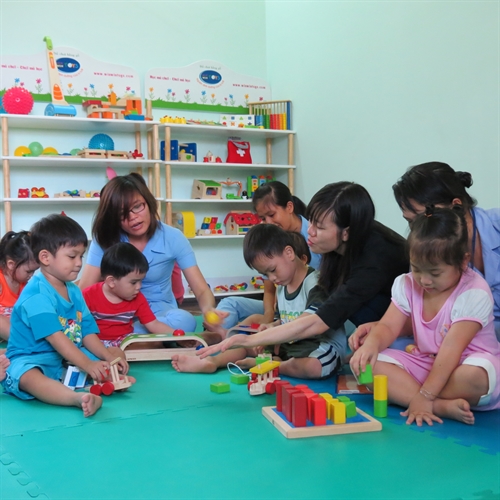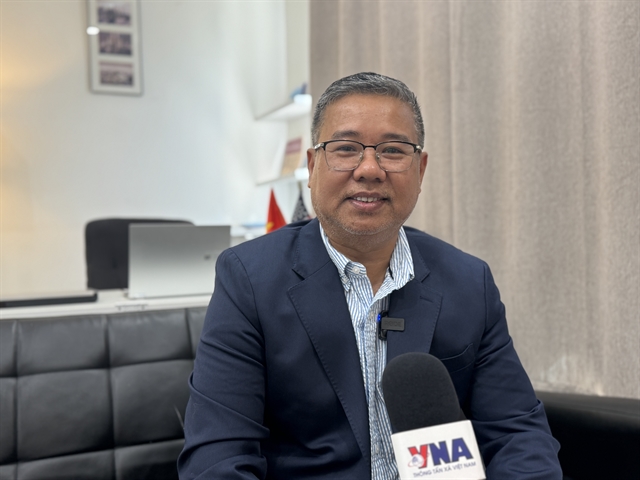 Society
Society

Hydrocephalus, a brain condition that can cause loss of mental and physical ability if left untreated, has not prevented a 10-year-old boy from playing football at a field in HCM City's Bình Thạnh District.
 |
| Children play at Tam Bình Centre for Children’s Nourishment and Protection in HCM City’s Thủ Đức District. VNS Photo Gia Lộc |
Gia Lộc
HCM CITY — Hydrocephalus, a brain condition that can cause loss of mental and physical ability if left untreated, has not prevented a 10-year-old boy from playing football at a field in HCM City’s Bình Thạnh District.
The boy’s persistence can be attributed to the enthusiastic care and treatment from social workers who work at the shelter where the boy has lived since he was a baby.
He is one of more than 51,100 disadvantaged children benefiting from the city’s project on social work development for the 2011-2015 period.
Speaking at a conference this week reviewing the project, Lê Chu Giang, head of the Department of Labour, Invalids and Social Affairs’ social welfare division, said social work services were offered at shelters, social welfare centres, hospitals and schools.
The city is designated as a “special urban area” by the government, with a large number of people receiving social welfare.
At least 453,990 people aged 60 and over receive welfare, along with 49,690 people with disabilities and 51,152 disadvantaged children.
Social workers and social welfare centres in the city play an important role in providing assistance to ensure that recipients receive their welfare benefits.
They are also responsible for giving advice in several areas, such as poverty reduction, compulsory high school education, vocational training for rural labour, child care and protection, and assistance for people who leave rehabilitation centres and re-enter society.
The city has nearly 5,000 social workers, but many of them have not been trained professionally.
Despite the high number, there are still not enough to meet demand. At least 90 public and private social welfare establishments and rehabilitation centres operate in the city.
To improve services, the city People’s Committee has approved allocation of VNĐ28.4 billion (US$12.6 million) to improve social work training and services from now to 2020, according to the city’s Department of Labour, Invalids and Social Affairs.
During this period, the city will continue to offer professional training to social workers employed in wards, communes and towns.
It also plans to open a centre for social welfare services in each district, according to Lê Chu Giang, head of the department’s Social Welfare Division. The first centre will be built in District 12 this year.
The city has set the goal of having at least one or two freelancers working as social workers in each ward, commune or town under the Ministry of Labour, Invalids, and Social Affairs’ regulation.
Social work activities at hospitals and schools will also be given more attention.
Hospital, school-based social work
By 2020, each hospital in the city is expected to have a division or team in charge of social work.
Last year, 16 hospitals had such a centre. Social workers work with health officials to provide psychological and social assistance to patients. More than 34,950 patients received assistance last year.
These divisions were able to raise patient satisfaction from 90 per cent in 2010 to 98 per cent last year.
Social workers also work with enterprises, individuals and organisations to provide free meals and funds for treatment and other services.
HCM City is a leader in the school-counselling field, but a shortage of staff specialists and facilities is preventing schools from offering professional career and psychological counselling to students.
Speaking at a recent conference on school counselling in HCM City, Dr Nguyễn Thị Hoài Hương of the HCM City Institute for Development Studies said only 120 staff work as specialists in school counselling.
However, the Department of Education and Training requires one staff specialist at each school. The specialist must be a university graduate in psychology.
The figure is higher than the 29 staff counsellors employed at schools in 2011.
Of 938 schools in the city, 891 offer counselling services, but most of the services are provided by teachers and staff in charge of the Communist Youth Union, or general supervisors.
Hương said that school leaders should work with oragnisations to open training courses for staff who have not been trained in counselling or psychology.
Only 71 of the schools in the city have a room dedicated to counselling services.
Hương said that counselling services primarily focused on preventing violence and reducing stress, or on sex education and advice about occupational orientation.
Trần Anh Tuấn, deputy director for the Centre for Human Resource Forecasting and Labour Information, said that occupational orientation advice had helped “students reduce psychological pressure to study at university after high school”.
Students have been advised to pursue colleges or vocational schools if they do not want to pursue a university education.
Thanks to counselling about jobs, many students have chosen a career needed by society and not one preferred by their parents.
Nguyễn Thị Thanh Hường, who is in charge of counselling services at Bình Hưng Hòa High School in Bình Tân District, said that teachers and managers should be more aware of the importance of counselling services and ask for their help when needed.
Vũ Thị Ngọc Bích of Thủ Dầu Một University in Bình Dương Province said that staff specialists providing career and psychology services were vital for educational development.
The conference was held by the HCM City Institute for Development Studies in co-operation with the Department of Education and Training and University of Social Sciences and Humanities. —VNS




